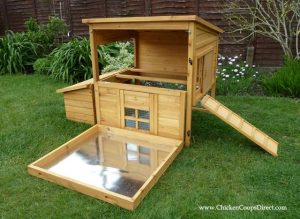
Dorset Coop Open for Cleaning
Poultry Housing – Chicken Coops Checklist
Check the coop’s timber
Has it has been treated so that it will stand up to the weather? Tanalized, protimized or cuprinoled timber are popular choices. Pressure treatment is the most effective because it ensures the maximum degree of penetration.
Creosote is used by some manufacturers. This needs to be completely dry and ‘weathered’ before hens can be introduced, so that they are not affected by its toxicity.
If you are re-proofing a house at any time, remember to buy proofer that is non-toxic to bats. (Bats are protected by law in Britain and builders are required to use proofers in the roof timbers that will not harm them). If it’s safe for bats, it’s alright for chickens!
Dimensions of the support timbers
These are normally 2-3 cm thick. If they are too thin the structure may not be strong enough. If too thick, the house may be difficult to move.
Is the roof of the poultry house sound?
The roof should have an overhang for shedding water. It may be a pitched roof, coming to a point at the top, or be angled away from the door so that water is shed backwards. It may be wood covered with bitumenized felt or be made of a modern material such as Onduline. The latter is popular because it does not provide hiding places for mites which can take up residence in the roof felt. Whatever the construction, it needs to be drip-proof and have a good level of insulation.
How easy is it to move?
If the house is a movable one, how is this accomplished? Some houses have wheels, while others may have them offered as an optional extra. The structure needs to be easy to grasp if it is relatively small, so carrying handles need to be provided in the appropriate positions. A larger house may have skids rather than wheels so that it can be pulled. If the house is to be moved by one person, it needs to be easily accomplished or the task can become a nightmare.
Easy access to the inside of the coop
Does the house have a poultry keeper’s door or is there a ‘lift-up’ section of the roof. Whatever it is, it needs to provide easy and convenient access to the inside of the house for cleaning, and so on.
What is the floor of the coop like?
It may be solid-boarded which is warm, or slatted which is colder but does allow droppings to fall through. An alternative to slats is a rigid metal mesh floor that is more secure against rodents.
Is the poultry house well ventilated?
Stale air can cause health problems so a house needs to provide fresh air without draughts. Depending on the size of house, ventilation is provided by a window, roof ridge or ventilation holes covered with galvanized wire mesh. Check that air inlets can be opened and closed easily.
Is there a pop-hole?
A ‘pop-hole’ entrance allows birds in and out of the house. This is normally closed by mean of a sliding shutter or ‘drop-down’ ramp. It is a useful feature to be able to open or close the pop-hole door from outside a run, otherwise you will need to go into the run. All doors, pop-holes and windows should fasten firmly to exclude predators. A lock may also be appropriate to deter thieves. Pop-holes are around 25cm wide x 30cm. Big birds they may need 30cm x 38cm.
Perches
There needs to be a perch for the birds to sleep on at night, with a minimum 20 cm of space per bird (30 cm if you have large birds). The width is 4-5 cm and slightly rounded at the sides for ease of grasping. Ideally the perch should be placed higher than the nest boxes so that the chickens are not encouraged to sleep in the latter. If there is more than one perch they need to be arranged in such a way that chickens are not directly below each other. The perches should be easy to remove for ease of cleaning.
Is there a droppings board?
A droppings board beneath the perch is useful for catching droppings in such a way that they are easily removed by sliding out the board. Alternatively, thick plastic sheeting can be placed under the perches. In a shed or outbuilding, a droppings pit or box with mesh cover or slats may be used.
Nest boxes
Nest boxes need to be placed low down in the darkest area of the house because this will discourage egg eating. There should be one nest box for every three birds, with wood shavings or sawdust as a liner. Make sure that the shavings are from non-treated wood otherwise they may be toxic. Wood shavings are preferable to hay or straw which may harbour mites and become mouldy with disease causing spores of Aspergillus fumigatus or ‘Farmer’s Lung’ can also affect humans.
It is possible to use nest boxes that slope backwards, with a collecting bay at the back, so hens cannot reach the eggs and be tempted to peck them. Nest boxes should be accessible to the poultry keeper from outside the house.
Is the house easy to keep clean?
The fittings should be easily removed for cleaning and the house itself should also be easy to dismantle. A stiff brush and dustpan are good cleaning tools, but having a droppings board or polythene, as referred to above, saves a lot of time and effort.
This article is taken from Starting with Chickens by Katie Thear
Further Articles on Keeping Chickens
- DIY Chicken Coop Planning – Building Your Own Chicken Coop
- Poultry Housing – Chicken Coops Checklist
- Poultry Housing – Chicken Fencing & Protection
- Poultry Housing – The Chicken Run
- Poultry Housing – Where to Buy Chicken Coops
- Omlet Automatic Chicken Coop Door Review & Test

